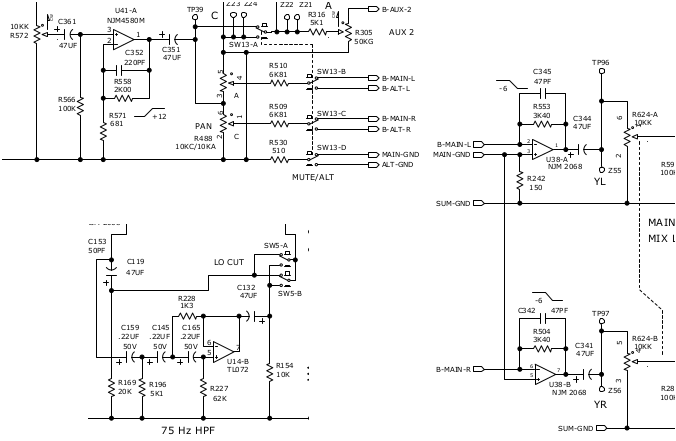Bo Deadly
Well-known member
Does anyone have an opinion about Mackie mixers?
I have never owned a mixer but occasionally I wish I did. I know I don't really need one (I should be writing code!) but these things are so cheap now how can I not own a mixer?! That's like not having a cordless power drill.
Looking at Mackie VLZ service manuals, I can't really see any major problems. The PS is totally normal. Mic amps are CFP which is at least as good as any other transparent mic pre (minus the better THD of CFIA amps like THAT chips). It's all NJM4560 which are pretty good amps IMO. The mix resistors are only 5K1. The main mix amps are NJM2068 which I've never heard of but presumably they're different for a reason. There's no stupid high-Z or gimmicky stuff in the signal path. EQ is simple and to-the-point mid control with BAX. Unbalanced outs are actually 120R quasi-balanced which are arguably better than balanced if you're not driving long lines. Balanced outputs have 120R buildout resistors which is fine (I would prefer slightly lower since I have some 600 ohm passive stuff that is damped for 100R but it's close enough).
So has anyone had experience with these? Don't be ashamed to admit it! Is pot tracking bad? Are there problems with crosstalk? Are they known to be defective / break in some way? Has anyone actually cracked one open and hacked on it? There are piles of these things on Ebay for less than $200 USD.
What's a good alternative small / cheap mixer? Allen-Heath? Soundcraft? I don't want anything that needs re-capping so it needs to be newish.
Specifically I'm looking at the Mackie 1202vlz4 largely because it's the smallest mixer that has an alternate group bus that isn't unconditionally tied to the main bus (piggy-backed on the Mute button which is slightly clever) which effectively means you can have two completely separate mixes.
I have never owned a mixer but occasionally I wish I did. I know I don't really need one (I should be writing code!) but these things are so cheap now how can I not own a mixer?! That's like not having a cordless power drill.
Looking at Mackie VLZ service manuals, I can't really see any major problems. The PS is totally normal. Mic amps are CFP which is at least as good as any other transparent mic pre (minus the better THD of CFIA amps like THAT chips). It's all NJM4560 which are pretty good amps IMO. The mix resistors are only 5K1. The main mix amps are NJM2068 which I've never heard of but presumably they're different for a reason. There's no stupid high-Z or gimmicky stuff in the signal path. EQ is simple and to-the-point mid control with BAX. Unbalanced outs are actually 120R quasi-balanced which are arguably better than balanced if you're not driving long lines. Balanced outputs have 120R buildout resistors which is fine (I would prefer slightly lower since I have some 600 ohm passive stuff that is damped for 100R but it's close enough).
So has anyone had experience with these? Don't be ashamed to admit it! Is pot tracking bad? Are there problems with crosstalk? Are they known to be defective / break in some way? Has anyone actually cracked one open and hacked on it? There are piles of these things on Ebay for less than $200 USD.
What's a good alternative small / cheap mixer? Allen-Heath? Soundcraft? I don't want anything that needs re-capping so it needs to be newish.
Specifically I'm looking at the Mackie 1202vlz4 largely because it's the smallest mixer that has an alternate group bus that isn't unconditionally tied to the main bus (piggy-backed on the Mute button which is slightly clever) which effectively means you can have two completely separate mixes.



